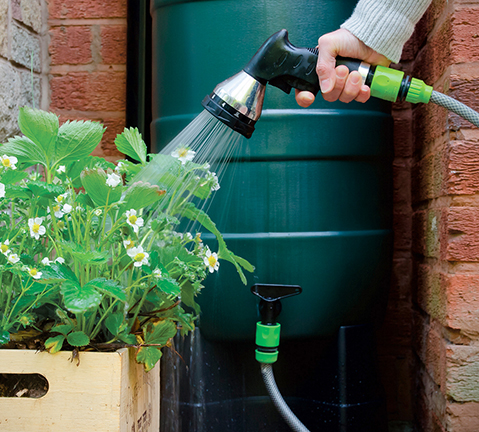Raindrops Keep Falling on My Rain Barrel?
 April showers bring May flowers, or so the saying goes. With all this moisture in the air and the likelihood of more extreme storms coming our way, it brings to mind the concept of rainwater harvesting.
April showers bring May flowers, or so the saying goes. With all this moisture in the air and the likelihood of more extreme storms coming our way, it brings to mind the concept of rainwater harvesting.
In ancient times, this was a very common practice, as many societies around the globe depended on rainwater for a myriad of uses—not the least of which was drinking water. And not that long ago, here in the United States, most rural home sites depended on rainwater for numerous functions as well.
The most basic way to capture rainwater is in a rain barrel. These are relatively simple products composed of a 55-gallon drum, a vinyl hose, PVC couplings, and a screen grate to keep debris and insects out.
At its most basic level, this can allow you to divert the water from your downspouts into a container that you can use to water your lawn, top off a pool, or wash a car. Forty percent of our water consumption in the summer months is used outside the home for the purposes mentioned above.
Even if you are not environmentally conscious, this is a great money saver because you’re using less potable water. Rain barrels are great for a DIY project over a weekend and can even be linked together to store even more water if necessary.
The next step up in capturing rain water would be a cistern. A cistern performs essentially like a large rain barrel. Best suited to concealment, typically cisterns are substantially buried with only a portion above ground. In a typical whole house system, all the downspouts would be tied together and would be diverted to the cistern. In the event (and this is quite common) that the cistern fills to the top, the excess will be diverted into an overflow area.
The interesting thing about a cistern is what you can do with this water going forward. Typically, this water would be tied to an irrigation system to water your lawn, planting beds, etc. Because they are designed with filters and pumps, this water can also be used like a hose bibb—so you can wash cars, clean the garage, etc. Looking beyond just the outdoor duties, let’s look at how this water can be used inside.
Twenty-five percent of the water we use indoors is just flushed down the toilet. Seriously, flushed down the toilet. We use perfectly good potable water, of which there is a worldwide shortage, to flush toilets every day. Why not use rainwater to flush your toilets instead? And just in case the cistern runs low, a home system is also tied to the main water supply in case you need it. Couple this concept with a dual flush toilet (yes, it does do exactly what it sounds like it does) and you will be conserving significant water.
In addition, there are places all over the world, as well as here in the US (Austin, Portland, and Hawaii), that are using purification methods to use rainwater for household use—potable water—for cooking, bathing, and drinking. This requires more complex systems that do two basic things. The first is to divert from the cistern what is called the “first flush” during a dry season. The first flush contains all the dirt, dust, pollutants, animal “stuff,” and other things that collect on roofs and gutters. Typically, that is accomplished in the first one inch of rainfall or less. The rest of the water will flow into the cistern. From that point, through the miracles of modern science and engineering, the water is filtered and purified. Obviously, this is a bit more complicated and does require maintenance and cleaning similar to that of a pool.
From the DIY to a more complex roof catchment system, we can see that rainwater harvesting is something that is of interest to all of us. Remember, any gesture, no matter how small, can help us move forward in the conservation of our most precious resource. So save that rainwater, and let’s garden together! ▼
Eric W. Wahl, RLA is a landscape architect at Element Design Group and president of the Delaware Native Plant Society.
